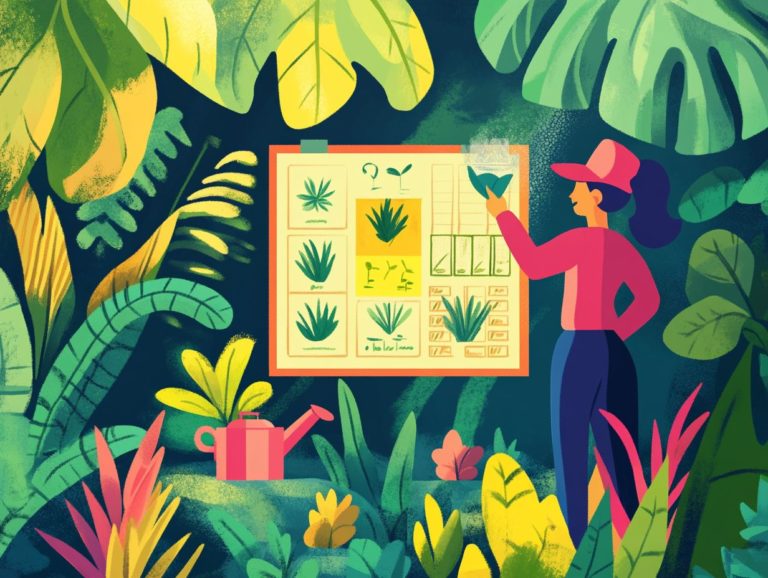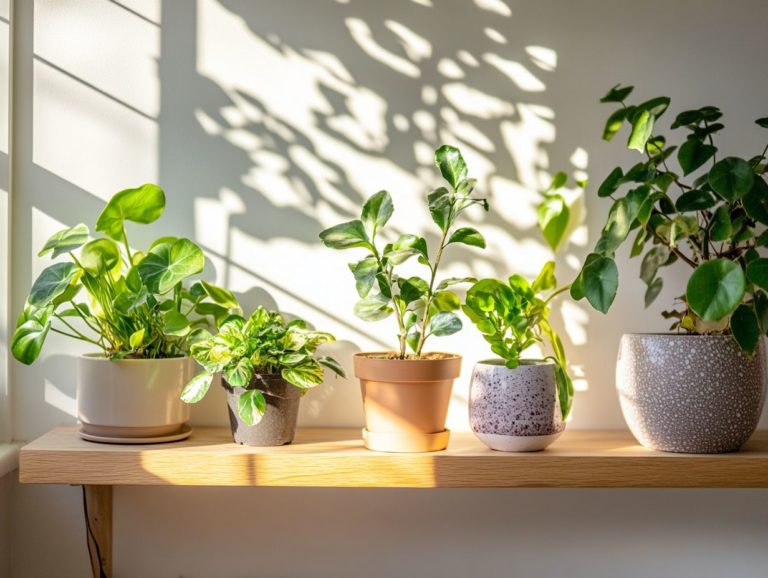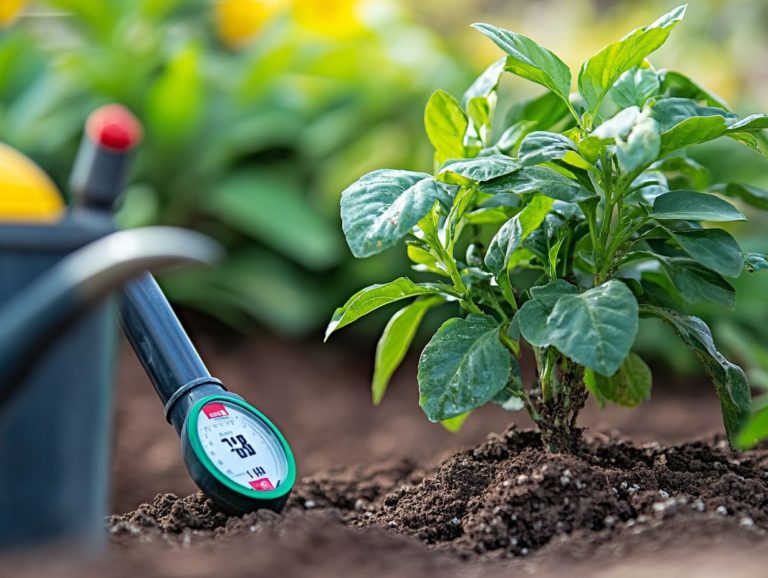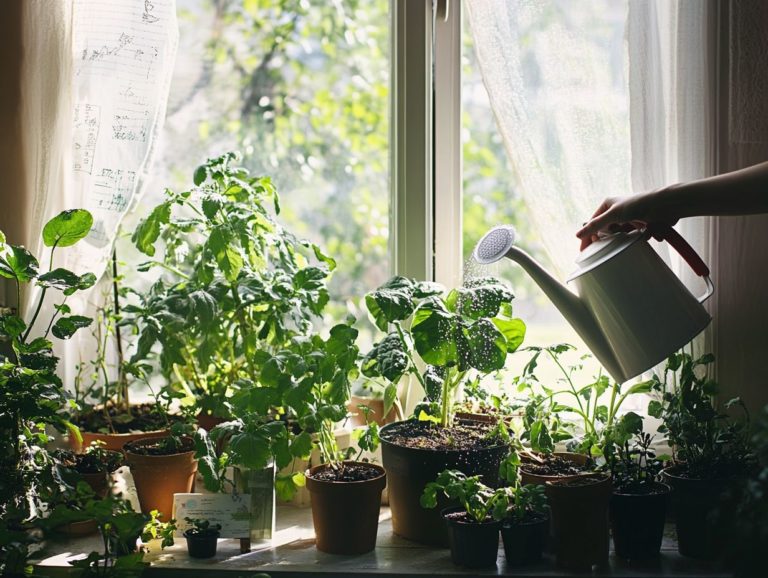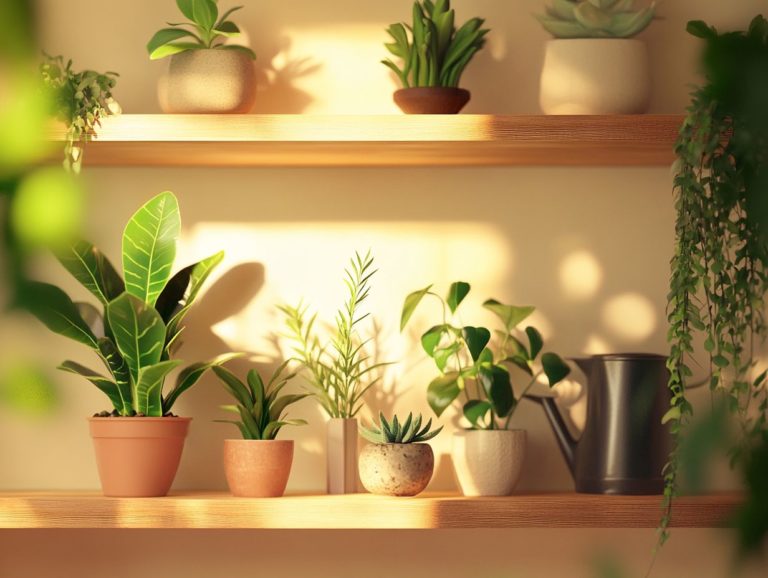The Best Time of Day to Water Indoor Plants
Watering indoor plants may seem simple, but the timing is crucial for their growth and overall health, especially considering the different types of houseplants.
A well-planned watering schedule can enhance a plant’s vitality, taking into account the specific type of plant, its indoor gardening challenges, and its environment.
Discover the best times to water morning, evening, or midday and get practical tips on effective watering techniques to check how wet your soil is. You’ll also learn to identify signs of over-watering, which can harm plant health.
This information is vital for ensuring your indoor garden thrives beautifully, supported by proper drainage solutions for pots.
Contents
- Key Takeaways:
- Why Watering Time Matters
- Factors to Consider
- Best Time of Day to Water Indoor Plants
- Tips for Watering Indoor Plants
- Frequently Asked Questions
- What is the best time of day to water my indoor plants?
- Why is it important to water indoor plants at a specific time?
- Can I water my indoor plants at night instead?
- Is it okay to water indoor plants in the afternoon?
- How often should I water my indoor plants during the best time of day?
- What if I forget to water my indoor plants in the morning?
Key Takeaways:
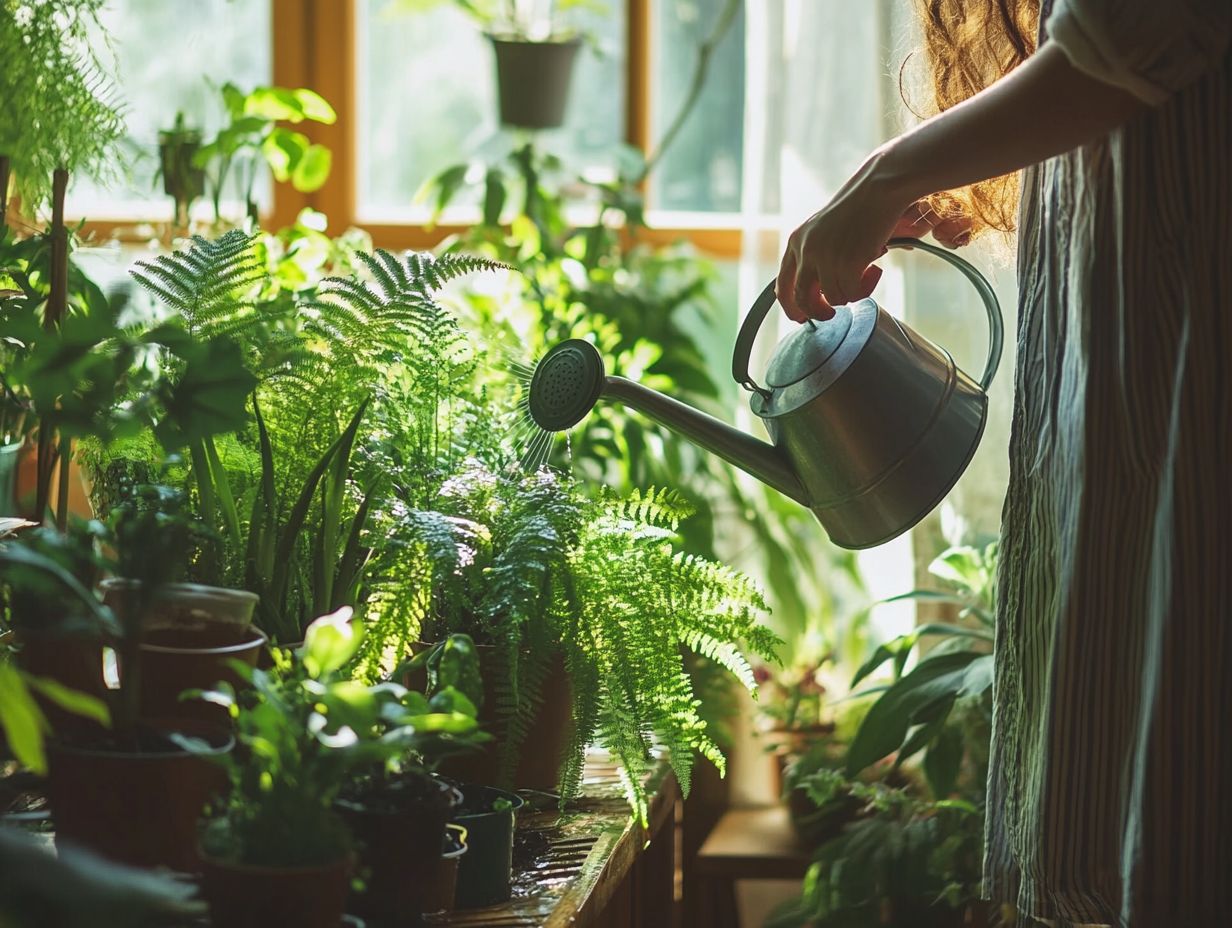
- The right watering time can make your plants thrive!
- The best time to water depends on your plant type, environment, and how often you water your houseplants.
- Morning watering is generally best for indoor plants, although evening and midday watering can work in some situations.
Why Watering Time Matters
Knowing when to water is key for healthy plants, especially since light exposure impacts their growth. Getting the timing right can greatly affect how wet the soil is, which influences the overall vitality of your houseplants.
Gardening experts like Andrea Beck and Joseph Tychonievich stress that the best time to water isn’t just a personal choice; it’s a strategic decision based on seasonal habits, plant types, and environmental conditions. By syncing your watering schedule with your plants’ natural growth patterns and following the best watering schedule for common plants, you can tackle indoor gardening challenges and help your plants achieve optimal health.
Effects of Timing on Plant Growth
The timing of when you water your indoor plants can significantly influence their growth and overall health.
Watering techniques and schedules are crucial for any indoor gardening routine; they can either encourage vibrant growth or lead to problems like root rot, dehydration, and increased risks of fungi and bacteria. For example, the best watering techniques for indoor plants suggest that watering in the early morning allows plants to absorb moisture before facing intense light, boosting photosynthesis and growth. Watering in the evening may cause the soil to stay wet longer, which increases the risk of fungal diseases.
It’s vital to adjust how often you water based on seasonal light changes. During winter, when light is limited, plants generally need less water, so adjustments are important. By understanding these essential tips, you can create a healthier indoor environment that flourishes.
Factors to Consider
To excel in caring for your houseplants, it’s important to understand the various factors that determine their watering needs this knowledge helps you keep your plants healthy.
Indoor plants’ requirements can differ dramatically based on their type, the environment they thrive in, and their seasonal watering habits. This necessitates a customized approach to watering frequency and quantity.
For instance, succulents typically need much less water than moisture-loving plants like Peace Lilies. Additionally, the type of soil you use significantly affects how quickly moisture is absorbed and retained, shaping your indoor gardening experience.
Plant Type and Environment
Different types of houseplants come with unique watering needs, shaped by their natural habitats and environmental conditions.
Take cacti, for example; they thrive in arid environments and require infrequent watering, as their desert homes offer very little moisture. On the other hand, philodendrons, hailing from tropical regions, flourish in high humidity and appreciate a more consistent hydration routine.
Grasping these differences in watering requirements not only sheds light on the influence of a plant’s original environment but also emphasizes how factors like humidity effects on plants and temperature are essential to their well-being.
Recreate these conditions at home. Use self-watering planters to give each plant the right amount of water, ultimately fostering vibrant growth and longevity.
Watering Frequency and Amount

Determining the right watering frequency and amount is essential for maintaining your indoor plants’ health and preventing issues like overwatering. Striking this careful balance cultivates a thriving environment for your plants to flourish.
Check your plants regularly! Look for signs of overwatering like yellowing leaves, wilting, or even mold appearing in the soil. Familiarize yourself with leaf wilting signs.
Utilizing effective methods for checking soil moisture can significantly enhance your approach. A moisture meter a tool that tells you if your plant needs water or simply inserting your finger about an inch into the soil can help you gauge whether your plant needs a drink.
By observing these indicators, you ensure your plants receive the right amount of hydration, promoting their overall vitality.
Best Time of Day to Water Indoor Plants
Make the most of your mornings! Water your plants early to maximize their growth, considering the importance of drainage holes, and minimize common problems such as leaf wilting and root rot. Watering in the morning is preferable, as it allows your plants to absorb moisture before the day heats up and increases evaporation rates making it the ideal time for most indoor species, especially using room temperature water.
By understanding the specific needs of your plants and their seasonal watering habits, as well as utilizing the importance of watering reminders, you can refine this practice even further. Setting effective watering reminders will ensure your plants thrive beautifully throughout the year.
Morning Watering
Watering your indoor plants in the morning sets the stage for optimal moisture absorption and readies them for the day’s light exposure. This practice ensures your plants receive sufficient hydration and prevents water from lingering in drainage holes, which can lead to root rot.
Embracing effective watering techniques during these early hours significantly boosts your plants’ growth and vitality.
Cooler morning temperatures mean lower evaporation rates, allowing for enhanced moisture retention in the soil especially advantageous for those delicate roots.
Ultimately, this thoughtful timing nurtures a thriving environment for lush foliage and vigorous development.
Evening Watering
Watering in the evening can be a smart move, especially in summer! However, be cautious of the associated risks.
As winter rolls in, the dynamics change quite a bit. The cooler temperatures mean slower evaporation, which can create a breeding ground for fungi and bacteria. Evening watering, especially if water lingers on the foliage overnight, may lead to unwelcome guests like powdery mildew or root rot due to the increased humidity.
Let s not forget about water quality; if it’s contaminated, those problems can escalate quickly. Navigating these risks is vital for maintaining a healthy garden. By being attentive to timing and closely monitoring weather conditions, you can strike the right balance for your plants.
Mid-day Watering
Mid-day watering can be a bit of a hot topic. It often leads to concerns about excessive evaporation and potential stress for many houseplants.
However, for certain plants like succulents, this approach might actually work in your favor. When considering watering strategies for succulents, these resilient varieties thrive in dry conditions. By watering them during the warmest part of the day, they can efficiently absorb moisture before the cooler evening temperatures arrive. For more insights, check out the science of watering indoor plants.
It’s also essential to consider humidity levels. In high humidity, water tends to linger longer, making mid-day watering less concerning for plant health. The temperature of the water also matters. Cooler water is typically more beneficial during the heat.
By grasping these nuances and integrating plant recovery methods, you can refine your watering strategies and significantly enhance your plants’ health.
Tips for Watering Indoor Plants
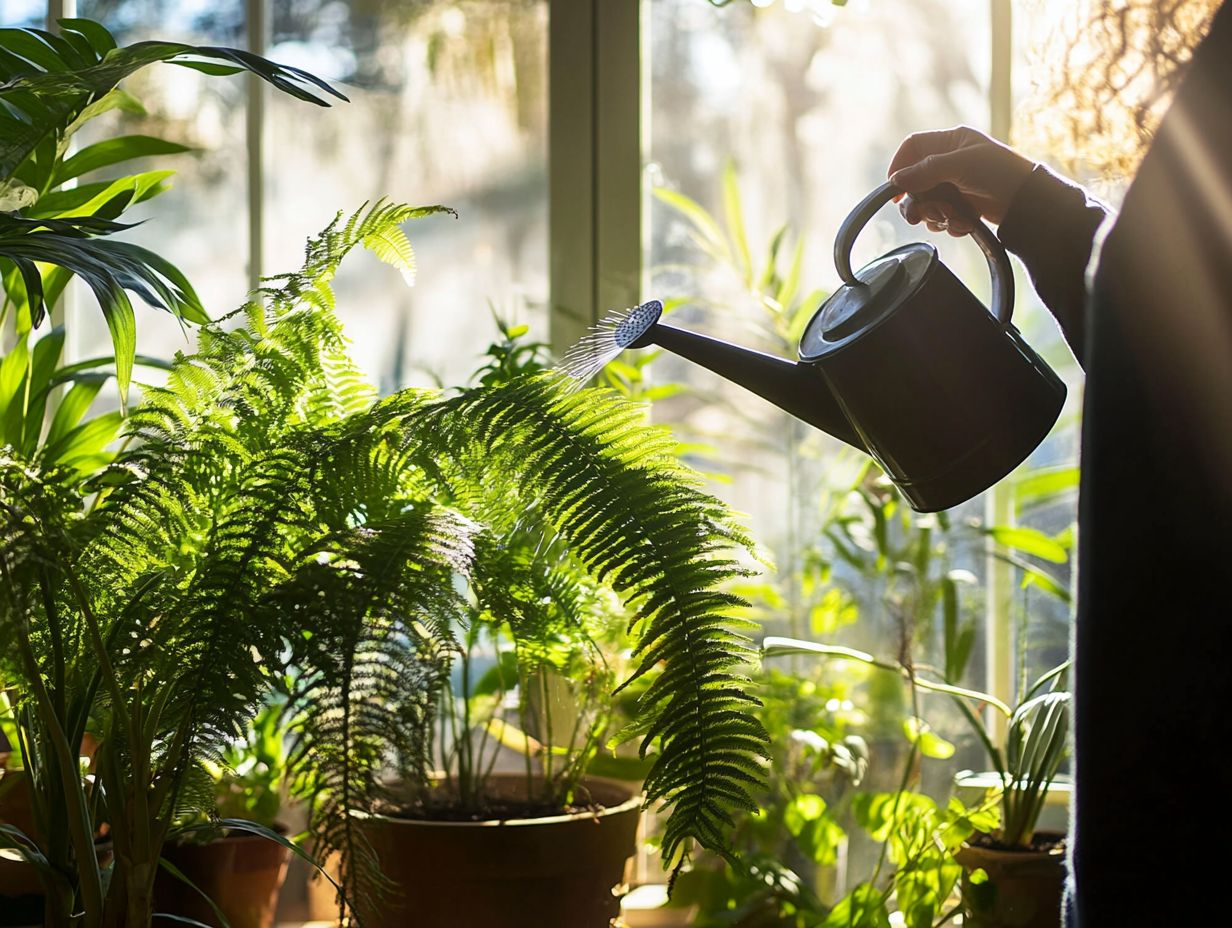
Effective watering techniques are important for keeping your plants healthy. Several tips can enhance the efficiency of your watering practices, including choosing the right types of watering cans.
Choosing the right watering tools can make a remarkable difference. For instance, a moisture meter is a tool that tells you how wet the soil is. This prevents both overwatering and under-watering, which is critical in houseplant care.
Being attuned to plant health indicators is crucial. Signs of leaf wilting enable you to adjust your watering strategy, ensuring your plants thrive beautifully.
Signs of Over or Under Watering
Recognizing the signs of over or under-watering is essential for maintaining plant health and cultivating a thriving indoor garden.
Both conditions present distinct symptoms. If identified promptly, they can enhance your plant’s resilience and overall vitality. For example, droopy leaves, yellowing foliage, or stunted growth may indicate either too much moisture or insufficient watering.
In cases of overwatering, the roots may start to rot, leading to a mushy texture. On the flip side, underwatering often results in crispy, brown leaf edges.
To help your plants bounce back, adjust your watering habits, ensure adequate drainage, and consider repotting when necessary for a healthier environment.
Watering Techniques and Tools
Using the right techniques and tools can make your indoor gardening journey exciting and rewarding!
Understanding the distinctions between top watering and bottom watering is crucial for plant health. Top watering involves pouring water directly onto the soil, allowing it to percolate down to the roots. However, this method can sometimes lead to overwatering or uneven moisture distribution.
In contrast, bottom watering promotes consistent moisture levels by placing pots in a tray of water, allowing the soil to absorb exactly what it needs.
The choice of watering can also plays a vital role. A narrow spout offers precise pouring for targeted hydration, while a wider opening may be more suitable for larger plants. To ensure your plants thrive, it’s important to know the best time to fertilize indoor plants. Ultimately, selecting the appropriate technique and tools not only enhances moisture retention but also fosters a flourishing indoor environment for your plants.
Adjusting Watering Schedule
Adjusting your watering schedule to align with the changing needs of your plants and the surrounding environment is essential for a thriving indoor garden.
By closely monitoring factors that influence plant health like temperature fluctuations, humidity levels, and seasonal changes, you can significantly enhance the vitality of your indoor greenery. Knowing the best time to propagate your indoor plants is also crucial. The quality of the water is important as well; contaminants can stunt growth and lead to various health issues for your plants.
Considering water quality, including the acidity of the water and any necessary treatments, empowers you to make more informed decisions. Regular assessments and adjustments are key to a thriving indoor garden, allowing your plants to flourish while minimizing common pitfalls.
Frequently Asked Questions
What is the best time of day to water my indoor plants?
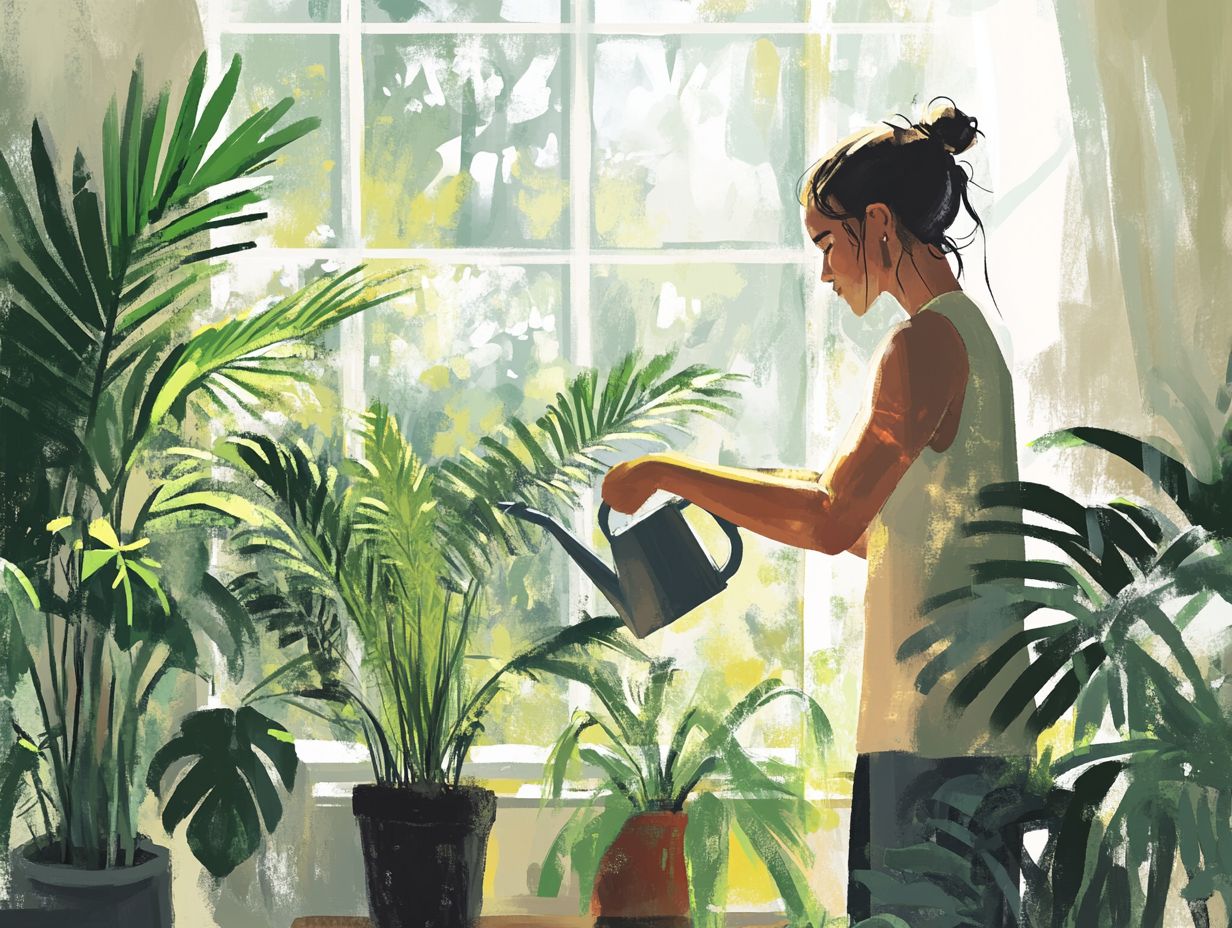
The best time of day to water indoor plants is in the morning, before the sun is fully up. This allows the water to be absorbed by the plants and their roots before the heat of the day evaporates it.
Why is it important to water indoor plants at a specific time?
Watering at the right time helps your plants get the moisture and nutrients they need to grow strong! Watering at the wrong time can lead to over or under-watering, which can harm the plants.
Can I water my indoor plants at night instead?
While it’s not recommended, you can water your indoor plants at night if necessary. However, be careful not to over-water as the soil may not have time to dry before the next watering. Also, avoid getting water on the leaves to prevent fungal growth.
Is it okay to water indoor plants in the afternoon?
Watering indoor plants in the afternoon is not ideal, as the heat and sunlight can cause the water to evaporate quickly. However, if your plants are wilting, a light misting can help revive them.
How often should I water my indoor plants during the best time of day?
The frequency of watering depends on the type of plant, its location, and the climate. As a general rule, most indoor plants require watering once or twice a week, but always check the soil moisture first to keep your plants happy!
What if I forget to water my indoor plants in the morning?
If you forget to water your plants in the morning, wait until the next day to water them at the right time. Avoid evening watering to prevent stagnant water, which increases the risk of root rot. Establish a regular watering schedule now to keep your plants thriving!
Start adjusting your watering schedule today for a healthier indoor garden!


